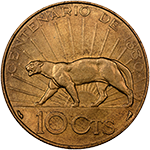France First Year of Issue Type Set
This is a collection of French coins of their modern period from the French Revolution of 1789 to today.
- Louis-Philippe I
- Second Republic
- Second Empire
- Third Republic
- WWII
- Fourth Republic
- Fifth Republic
- Other Countries
Louis-Philippe I, 1830-1848
Louis-Philippe
Engraved by Joseph-Francois Domard
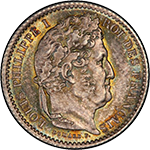
Second Republic, 1848-1852
After the Revolution of 1848 and overthrow of King Louis-Philippe, Louis-Napoléon Bonaparte was elected president the Second Republic. The constitution of the new republic was deemed impossible to work with, and in 1852 Louis-Napoléon instigated a coup d'Etat, and named himself Emperor Napoléon III of the Second Empire.
Dupré
Engraved by Augustin Dupré
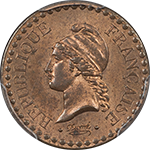
Hercules
Engraved by Augustin Dupré
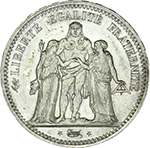
Dupre's Hercules
An exceedingly late issue for a silver coin, France minted this design from 1795-1980. It is largely unchanged from the original "Union et Force" design of 1795, and shows Hercules with two women representing the allegories of Liberty and Equality.
Louis-Napoléon Bonaparte
Engraved by Jacques-Jean Barre
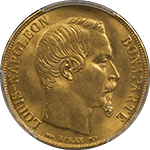
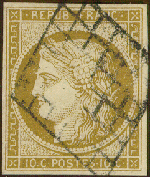
Jean-Jacques Barre was the general engraver at the Monnaie de Paris between 1842 and 1855. In this position, he engraved and designed coins, French medals, the Great Seal of France, bank notes and postage stamps. In 1849 France's first postage stamp was issued, depicting Ceres the goddess of agriculture, and designed by Barre.
Second Empire, 1852-1870
Napoléon III (Louis-Napoléon Bonaparte) ruled as Emperor of France during this Second French Empire, which fell after the losses in the Franco-Prussian War in 1870.
Napoléon III, Tête Nue
Engraved by Jacques-Jean Barre
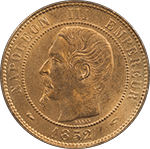
Napoléon III, Tête Laurée
Engraved by Jacques-Jean Barre
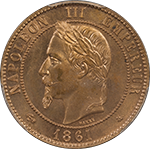
Third Republic, 1870-1940
The Third Republic was in place during the colonialization period and through WWI. It fell to Germany in WWII.
Numismatically, France moved to allegorical designs for its coins and banknotes with artists designing in the Art Deco and Art Nouveau styles during this period.
Hercules
Engraved by Augustin Dupré
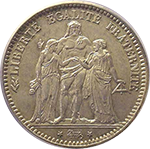
Dupre's Hercules
An exceedingly late issue for a silver coin, France minted this design from 1795-1980. It is largely unchanged from the original "Union et Force" design of 1795, and shows Hercules with two women representing the allegories of Liberty and Equality.
Ceres
Engraved by Eugène-André Oudiné
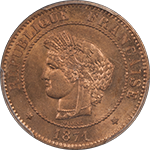
Dupuis
Engraved by Daniel Dupuis
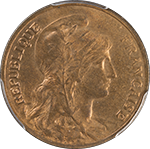
Semeuse
Engraved by Louis-Oscar Roty
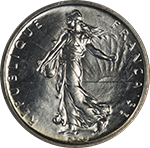
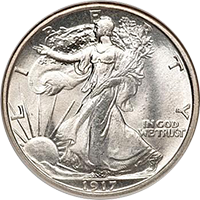
Originally comissioned as a prize medal for the French Ministry of Agriculture, Roty's "Semeuse" is likely France's most recognized symbol. It has been used since the 50c issue of 1897, up through the Euro coins, and similarly on French stamps.
The Sower issue is generally agreed to be the inspiration for Saint-Gauden's US $20 double eagle gold piece and Weinman's Walking Liberty half dollar.
Patey
Engraved by Henri-Auguste Patey
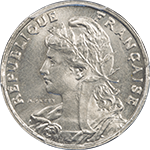
Henri-Auguste Patey studied sculpture with Henri Chapu and engraving and medal making with Jules-Clément Chaplain. He was admitted to the École Nationale Supérieure des Beaux-Arts in 1873. In 1875, he won the second Prix de Rome for medal engraving and in 1881 he won the first Grand prix de Rome, also for medal engraving. He won further prizes in 1886 (third), 1887 (second) and 1894 (first). At the Universal Exhibition of 1889 he won a bronze medal. He produced many portrait medals, not only of clients, but also of relatives and friends. He also authored decorations and patterns.
He succeeded Jean Lagrange as chief engraver of the Paris mint in 1896, a position he held until his death. He used a torch as his privy mark. In this position, Patey designed the nickel 25 Centimes 1903. This piece was generally rejected. It was the first copper-nickel coin in France. The white metal was taken for silver and the coin confused with the 1 franc, in spite of a completely different design. Coins with a different design and shape dated 1904 and 1905 were not accepted either. He did not design any other French coins after this double disappointments. Copper-nickel coins succeeded only in 1914, when holed coins were produced.
Marianne
Engraved by Jules-Clément Chaplain
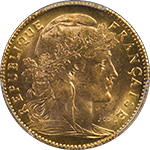
Lindauer (Cmes)
Engraved by Edmond-Emile Lindauer
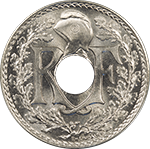
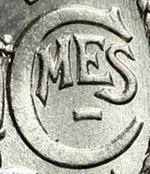
Dupre's Hercules
An exceedingly late issue for a silver coin, France minted this design from 1795-1980. It is largely unchanged from the original "Union et Force" design of 1795, and shows Hercules with two women representing the allegories of Liberty and Equality.
Lindauer
Engraved by Edmond-Emile Lindauer
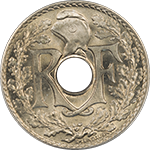

Dupre's Hercules
An exceedingly late issue for a silver coin, France minted this design from 1795-1980. It is largely unchanged from the original "Union et Force" design of 1795, and shows Hercules with two women representing the allegories of Liberty and Equality.
Chambre de Commerce
Designed by Joseph-François Domard

After World War I, France was a poor country. Issuance of coinage in silver and gold, and even copper, was discontinued. Despite calls for German reparations, France was in no way "re-payed" for the war. Emergency Money, issued by local chambers of commerce, was issued both in paper, and in coin form in much cheaper metals.
]]>Turin
Engraved by Pierre Turin
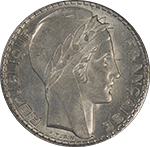
Morlon
Engraved by Pierre-Alexandre Morlon
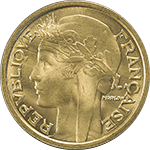
Bazor
Engraved by Lucien Bazor
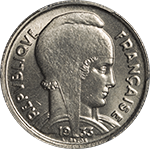
Lucien Georges Bazor (1889–1974) was Chief Engraver at the Paris mint from 1930 to 1958. He was born in Paris in 1889 and initially studied under his father, Albert Bazor. Bazor later became the pupil of Patey at the École Nationale Supérieure des Beaux-Arts. He won the Grand Prix de Rome in 1923 for his engraving.
Lavrillier
Engraved by André-Henri Lavrillier
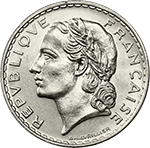
Lindauer ( · date · )
Engraved by Edmond-Emile Lindauer
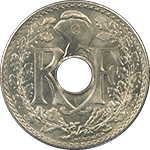

Dupre's Hercules
An exceedingly late issue for a silver coin, France minted this design from 1795-1980. It is largely unchanged from the original "Union et Force" design of 1795, and shows Hercules with two women representing the allegories of Liberty and Equality.
French State, 1940-1944
From June 25, 1940 to August 25, 1944, the North of France was occupied by the German forces, and the South of France was under the control of the Vichy government of Marshal Pétain. During this time, coinage was minted under "Etat Français" and the French motto was changed to "Travail, Famille, Patrie."]]>VINGT Centimes
Engraved by Atelier de Paris
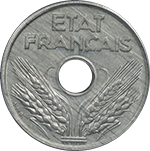
Morlon
Engraved by Pierre-Alexandre Morlon
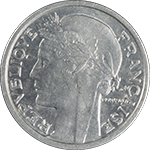
Francisque
Engraved by Lucien Bazor
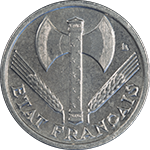
Free France, 1940-1944
The Fourth Republic was was largely a follow-on from the Third Republic, and presided over social reforms of the state, as well as playing a major role in European integration following the war. The Republic struggled, and finally collapsed, as a result of the de-colonization of many former colonies.
Philadelphia
Engraved by
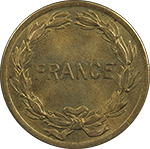
Provisionary Government, 1944-1947
After the Allied Forces, the Free French and the French Resistance liberated France from German occupation, this temporary government with Charles de Gaulle as president was in place until the Fourth Republic could be created.
Lindauer (Cmes)
Engraved by Edmond-Emile Lindauer
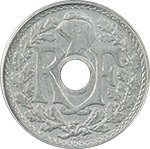

Dupre's Hercules
An exceedingly late issue for a silver coin, France minted this design from 1795-1980. It is largely unchanged from the original "Union et Force" design of 1795, and shows Hercules with two women representing the allegories of Liberty and Equality.
Lavrillier
Engraved by André-Henri Lavrillier

Fourth Republic, 1947-1958
The Fourth Republic was was largely a follow-on from the Third Republic, and presided over social reforms of the state, as well as playing a major role in European integration following the war. The Republic struggled, and finally collapsed, as a result of the de-colonization of many former colonies.
Giraud
Engraved by Georges Guiraud
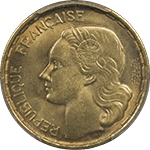
Cochet
Engraved by Robert Cochet
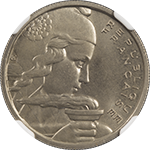
Fifth Republic, 1959-current
The current French Republic initially pulled Charles de Gaulle out of retirement to create a new constitution and a system of presidents with stronger powers than previously held. It also replaced the French Union with the French Community, in terms of its relationship with the colonies.
France devalued the franc by 1/100 in January 1960, so these new issues are in New Francs.
Epi
Engraved by Atelier de Paris
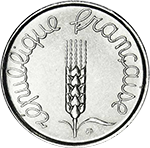
Semeuse
Engraved by Louis-Oscar Roty

Marianne
Engraved by Lagriffoul and Dieudonné
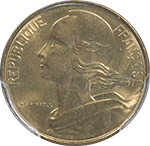
Hercules
Engraved by Atelier de Gravure (Augustin Dupré original design)
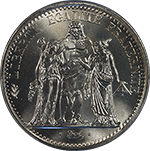
Dupre's Hercules
An exceedingly late issue for a silver coin, France minted this design from 1795-1980. It is largely unchanged from the original "Union et Force" design of 1795, and shows Hercules with two women representing the allegories of Liberty and Equality.
Mathieu
Engraved by E. Rousseau

Other Coins
Miscellaneous
